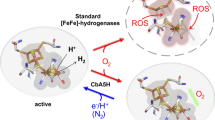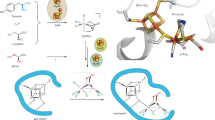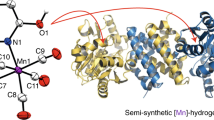Abstract
Nature is a valuable source of inspiration in the design of catalysts, and various approaches are used to elucidate the mechanism of hydrogenases, the enzymes that oxidize or produce H2. In FeFe hydrogenases, H2 oxidation occurs at the H-cluster, and catalysis involves H2 binding on the vacant coordination site of an iron centre. Here, we show that the reversible oxidative inactivation of this enzyme results from the binding of H2 to coordination positions that are normally blocked by intrinsic CO ligands. This flexibility of the coordination sphere around the reactive iron centre confers on the enzyme the ability to avoid harmful reactions under oxidizing conditions, including exposure to O2. The versatile chemistry of the diiron cluster in the natural system might inspire the design of novel synthetic catalysts for H2 oxidation.
This is a preview of subscription content, access via your institution
Access options
Subscribe to this journal
Receive 12 print issues and online access
$259.00 per year
only $21.58 per issue
Buy this article
- Purchase on Springer Link
- Instant access to full article PDF
Prices may be subject to local taxes which are calculated during checkout






Similar content being viewed by others
References
Carroll, M. E., Barton, B. E., Rauchfuss, T. B. & Carroll, P. J. Synthetic models for the active site of the [FeFe]-hydrogenase: catalytic proton reduction and the structure of the doubly protonated intermediate. J. Am. Chem. Soc. 134, 18843–18852 (2012).
Tard, C. & Pickett, C. J. Structural and functional analogues of the active sites of the [Fe]-, [NiFe]-, and [FeFe]-hydrogenases. Chem. Rev. 109, 2245–2274 (2009).
Liu, T., Dubois, D. L. & Bullock, R. M. An iron complex with pendent amines as a molecular electrocatalyst for oxidation of hydrogen. Nature Chem. 5, 228–233 (2013).
Fontecilla-Camps, J. C., Volbeda, A., Cavazza, C. & Nicolet, Y. Structure/function relationships of [NiFe]- and [FeFe]-hydrogenases. Chem. Rev. 107, 4273–4303 (2007).
Hsieh, C-H. et al. Structural and spectroscopic features of mixed valent FeIIFeI complexes and factors related to the rotated configuration of diiron hydrogenase. J. Am. Chem. Soc. 134, 13089–13102 (2012).
Greco, C., Bruschi, M., Fantucci, P., Ryde, U. & De Gioia, L. Isocyanide in biochemistry? A theoretical investigation of the electronic effects and energetics of cyanide ligand protonation in [FeFe]-hydrogenases. Chem. Eur. J. 17, 1954–1965 (2011).
Knörzer, P. et al. Importance of the protein framework for catalytic activity of [FeFe]-hydrogenases. J. Biol. Chem. 287, 1489–1499 (2012).
Roseboom, W., De Lacey, A. L., Fernandez, V. M., Hatchikian, E. C. & Albracht, S. P. J. The active site of the [FeFe]-hydrogenase from Desulfovibrio desulfuricans. II. Redox properties, light sensitivity and CO-ligand exchange as observed by infrared spectroscopy. J. Biol. Inorg. Chem. 11, 102–118 (2006).
De Lacey, A. L., Fernandez, V. M., Rousset, M. & Cammack, R. Activation and inactivation of hydrogenase function and the catalytic cycle: spectroelectrochemical studies. Chem. Rev. 107, 4304–4330 (2007).
Parkin, A., Cavazza, C., Fontecilla-Camps, J. C. & Armstrong, F. A. Electrochemical investigations of the interconversions between catalytic and inhibited states of the [FeFe]-hydrogenase from Desulfovibrio desulfuricans. J. Am. Chem. Soc. 128, 16808–16815 (2006).
Baffert, C. et al. Covalent attachment of FeFe hydrogenases to carbon electrodes for direct electron transfer. Anal. Chem. 84, 7999–8005 (2012).
Léger, C. & Bertrand, P. Direct electrochemistry of redox enzymes as a tool for mechanistic studies. Chem. Rev. 108, 2379–2438 (2008).
Fourmond, V., Infossi, P., Giudici-Orticoni, M-T., Bertrand, P. & Léger, C. ‘Two-step’ chronoamperometric method for studying the anaerobic inactivation of an oxygen tolerant NiFe hydrogenase. J. Am. Chem. Soc. 132, 4848–4857 (2010).
Greco, C., Bruschi, M., Fantucci, P., Ryde, U. & De Gioia, L. Mechanistic and physiological implications of the interplay among iron–sulfur clusters in [FeFe]-hydrogenases. A QM/MM perspective. J. Am. Chem. Soc. 133, 18742–18749 (2011).
Barton, B. E., Olsen, M. T. & Rauchfuss, T. B. Aza- and oxadithiolates are probable proton relays in functional models for the [FeFe]-hydrogenases. J. Am. Chem. Soc. 130, 16834–16835 (2008).
Camara, J. M. & Rauchfuss, T. B. Combining acid–base, redox and substrate binding functionalities to give a complete model for the [FeFe]-hydrogenase. Nature Chem. 4, 26–30 (2011).
Camara, J. M. & Rauchfuss, T. B. Mild redox complementation enables H2 activation by [FeFe]-hydrogenase models. J. Am. Chem. Soc. 133, 8098–8101 (2011).
Fernandez, V. M., Aguirre, R. & Hatchikian, E. C. Reductive activation and redox properties of hydrogenase from Desulfovibrio gigas. Biochim. Biophys. Acta 790, 1–7 (1984).
Dijk, C. v., Berkel-Arts, A. v. & Veeger, C. The effect of re-oxidation on the reduced hydrogenase of Desulfovibrio vulgaris strain Hildenborough and its oxygen stability. FEBS Lett. 156, 340–344 (1983).
Fernandez, V. M., Hatchikian, E. C., Patil, D. S. & Cammack, R. ESR-detectable nickel and iron-sulphur centres in relation to the reversible activation of Desulfovibrio gigas hydrogenase. Biochim. Biophys. Acta 883, 145–154 (1986).
Olsen, M. T., Rauchfuss, T. B. & Wilson, S. R. Role of the azadithiolate cofactor in models for [FeFe]-hydrogenase: novel structures and catalytic implications. J. Am. Chem. Soc. 132, 17733–17740 (2010).
Miyake, T. et al. Does the environment around the H-cluster allow coordination of the pendant amine to the catalytic iron center in [FeFe] hydrogenases? Answers from theory. J. Biol. Inorg. Chem. 18, 693–700 (2013).
Zaffaroni, R., Rauchfuss, T. B., Fuller, A., De Gioia, L. & Zampella, G. Contrasting protonation behavior of diphosphido vs dithiolato diiron(I) carbonyl complexes. Organometallics 32, 232–238 (2012).
Apfel, U.-P. et al. Models for the active site in [FeFe] hydrogenase with iron-bound ligands derived from bis-, tris-, and tetrakis(mercaptomethyl)silanes. Inorg. Chem. 49, 10117–10132 (2010).
Dong, W. et al. An insight into the protonation property of a diiron azadithiolate complex pertinent to the active site of Fe-only hydrogenases. Chem. Commun. 305–307 (2006).
Ezzaher, S., Gogoll, A., Bruhn, C. & Ott, S. Directing protonation in [FeFe] hydrogenase active site models by modifications in their second coordination sphere. Chem. Commun. 46, 5775–5777 (2010).
Silakov, A., Kamp, C., Reijerse, E., Happe, T. & Lubitz, W. Spectroelectrochemical characterization of the active site of the [FeFe] hydrogenase HydA1 from Chlamydomonas reinhardtii. Biochemistry 48, 7780–7786 (2009).
Vignais, P. M. & Billoud, B. Occurrence, classification, and biological function of hydrogenases: an overview. Chem. Rev. 107, 4206–4272 (2007).
Fritsch, J. et al. The crystal structure of an oxygen-tolerant hydrogenase uncovers a novel iron–sulphur centre. Nature 479, 249–252 (2011).
Shomura, Y., Yoon, K-S., Nishihara, H. & Higuchi, Y. Structural basis for a [4Fe–3S] cluster in the oxygen-tolerant membrane-bound [NiFe]-hydrogenase. Nature 479, 253–256 (2011).
Mouesca, J-M., Fontecilla-Camps, J. C. & Amara, P. The structural plasticity of the proximal [4Fe3S] cluster is responsible for the O2 tolerance of membrane-bound [NiFe] hydrogenases. Angew. Chem. Int. Ed. 52, 2002–2006 (2013).
Bruschi, M., Fantucci, P. & De Gioia, L. DFT investigation of structural, electronic, and catalytic properties of diiron complexes related to the [2Fe]H subcluster of Fe-only hydrogenases. Inorg. Chem. 41, 1421–1429 (2002).
Bruschi, M., Fantucci, P. & De Gioia, L. Density functional theory investigation of the active site of [Fe]-hydrogenases: effects of redox state and ligand characteristics on structural, electronic, and reactivity properties of complexes related to the [2Fe]H subcluster. Inorg. Chem. 42, 4773–4781 (2003).
Sybirna, K. et al. Shewanella oneidensis: a new and efficient system for expression and maturation of heterologous [Fe–Fe] hydrogenase from Chlamydomonas reinhardtii. BMC Biotechnol. 8, 1–8 (2008).
Baffert, C. et al. CO disrupts the reduced H-cluster of FeFe hydrogenase. A combined DFT and protein film voltammetry study. J. Am. Chem. Soc. 133, 2096–2099 (2011).
Girbal, L. et al. Homologous and heterologous overexpression in Clostridium acetobutylicum and characterization of purified clostridial and algal Fe-only hydrogenases with high specific activities. Appl. Environ. Microbiol. 71, 2777–2781 (2005).
Lautier, T. et al. The quest for a functional substrate access tunnel in FeFe hydrogenase. Faraday Discuss. 148, 385–407 (2011).
Liebgott, P-P. et al. Relating diffusion along the substrate tunnel and oxygen sensitivity in hydrogenase. Nature Chem. Biol. 6, 63–70 (2010).
Fourmond, V. et al. SOAS: a free program to analyze electrochemical data and other one-dimensional signals. Bioelectrochemistry 76, 141–147 (2009).
Boggs, P. T., Donaldson, J. R., Byrd, R. H. & Schnabel, R. B. Algorithm 676: ODRPACK: software for weighted orthogonal distance regression. ACM Trans. Math. Softw. 15, 348–364 (1989).
Scott, W. R. P. et al. The GROMOS biomolecular simulation program package. J. Phys. Chem. A 103, 3596–3607 (1999).
Berendsen, H. J. C., Grigera, J. R. & Straatsma, T. P. The missing term in effective pair potentials. J. Phys. Chem. 91, 6269–6271 (1987).
Hess, B., Kutzner, C., van der Spoel, D. & Lindahl, E. GROMACS 4: algorithms for highly efficient, load-balanced, and scalable molecular simulation. J. Chem. Theory Comput. 4, 435–447 (2008).
Ahlrichs, R., Bär, M., Häser, M., Horn, H. & Kölmel, C. Electronic structure calculations on workstation computers: the program system TURBOMOLE. Chem. Phys. Lett. 162, 165–169 (1989).
Becke, A. D. Density-functional exchange-energy approximation with correct asymptotic behavior. Phys. Rev. A 38, 3098–3100 (1988).
Perdew, J. P. Density-functional approximation for the correlation energy of the inhomogeneous electron gas. Phys. Rev. B 33, 8822–8824 (1986).
Weigend, F. & Ahlrichs, R. Balanced basis sets of split valence, triple zeta valence and quadruple zeta valence quality for H to Rn: design and assessment of accuracy. Phys. Chem. Chem. Phys. 7, 3297–3305 (2005).
Noodleman, L. Valence Bond Description of Anti-Ferromagnetic Coupling in Transition Metal Dimers. J. Chem. Phys. 74, 5737–5743 (1981).
Greco, C., Fantucci, P., Ryde, U. & De Gioia, L. Fast generation of broken-symmetry states in a large system including multiple iron-sulfur assemblies: investigation of QM/MM energies, clusters charges, and spin populations. Int. J. Quantum Chem. 111, 3949–3960 (2011).
Pandey, A. S., Harris, T. V., Giles, L. J., Peters, J. W. & Szilagyi, R. K. Dithiomethylether as a ligand in the hydrogenase H-cluster. J. Am. Chem. Soc. 130, 4533–4540 (2008).
Acknowledgements
The authors thank S. Dementin for helpful discussions and critical reading of the manuscript. The authors acknowledge funding from Centre National de la Recherche Scientifique, Aix-Marseille Université and Agence Nationale de la Recherche (ANR-12-BS08-0014 and ANR-2010-BIOE-004). L.D.G. acknowledges support from Ministero dell'Istruzione, dell'Università e della Ricerca (Prin 2010M2JARJ). P.W. acknowledges the Ministry of Education, Republic of China (Taiwan) for a PhD scholarship, and J.B. acknowledges the Engineering and Physical Sciences Research Council, grant EP/J015571/1, and the Royal Society for a University Research Fellowship. The UK's High Performance Computing Materials Chemistry Consortium (funded by the Engineering and Physical Sciences Research Council, EP/ F067496) is acknowledged for access to the high-performance computing facility HECToR.
Author information
Authors and Affiliations
Contributions
V.F., C.G., C.B., J.B., L.D.G. and C.L. designed the experiments. V.F., C.G., P-H.W., P.E., M.M. and M.B. performed the experiments. V.F., C.G., J.B., L.D.G. and C.L. analysed the data. K.S. and H.B. provided the enzyme from Cr and constructed the mutants. I.M-S. and P.S. provided the enzyme from Ca. V.F., C.G., C.B., J.B., L.D.G. and C.L. co-wrote the paper.
Corresponding author
Ethics declarations
Competing interests
The authors declare no competing financial interests.
Supplementary information
Supplementary information
Supplementary information (PDF 2056 kb)
Rights and permissions
About this article
Cite this article
Fourmond, V., Greco, C., Sybirna, K. et al. The oxidative inactivation of FeFe hydrogenase reveals the flexibility of the H-cluster. Nature Chem 6, 336–342 (2014). https://doi.org/10.1038/nchem.1892
Received:
Accepted:
Published:
Issue Date:
DOI: https://doi.org/10.1038/nchem.1892
This article is cited by
-
Suppressing hydrogen peroxide generation to achieve oxygen-insensitivity of a [NiFe] hydrogenase in redox active films
Nature Communications (2020)
-
Advancing photosystem II photoelectrochemistry for semi-artificial photosynthesis
Nature Reviews Chemistry (2019)
-
Mechanism of O2 diffusion and reduction in FeFe hydrogenases
Nature Chemistry (2017)
-
[FeFe]-hydrogenases as biocatalysts in bio-hydrogen production
Rendiconti Lincei (2017)
-
Lyophilization protects [FeFe]-hydrogenases against O2-induced H-cluster degradation
Scientific Reports (2015)



